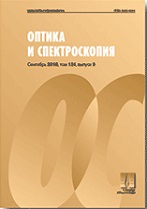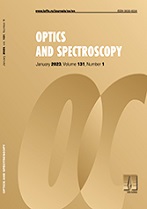|
This article is cited in 7 scientific papers (total in 7 papers)
Spectroscopy of condensed matter
RRS spectra and mechanisms for $\beta$-nitro-tetraphenylporphyrin fluorescence quenching
N. V. Ivashin, S. N. Terekhov
B. I. Stepanov Institute of Physics, National Academy of Sciences of Belarus, Minsk
Abstract:
The study of the excited states and photophysical characteristics of $\beta$-nitro-tetraphenylporphyrin (TPP–NO$_2$) has been carried out using resonance Raman scattering (RRS) spectroscopy and methods of the density functional theory. The appearance of new lines, the intensity of which depends on the composition of the matrix and excitation wavelength, has been found in the TPP–NO$_2$ RRS spectra in the low-temperature matrix. The calculation of the vibrational states of TPP–NO$_2$ allowed the linking of the additional lines with the asymmetric vibrations of the nitro group and valence C–C vibrations of the phenyl ring (Ph1) that was nearest to it. The activation of these modes is related to the specific features of the TPP–NO$_2$ geometry in the charge transfer (CT) state from Ph1 to the porphyrin macrocycle. It has been concluded on the basis of the analysis of the data of the study of the RRS spectra and the results of calculations that use the СAM-B3LYP and wB97XD functionals that the CT states do not play a significant role in the TPP–NO$_2$ fluorescence quenching, as previously assumed. The fluorescence quenching owes to strengthening channels of internal and inter-conversion by reducing the energy gaps $\Delta E(S_{1}-T_{1})$ and $\Delta E(S_{1}-S_{0})$ as well as increasing the spin-orbit coupling between the $S_1$ and $T_1$ states. It has been shown that TPP–NO$_2$ is characterized by conformational heterogeneity both in the ground and in the excited states, which explains the absence of the monoexponentiality of fluorescence decay kinetics.
Received: 02.10.2018
Revised: 02.10.2018
Accepted: 12.11.2018
Citation:
N. V. Ivashin, S. N. Terekhov, “RRS spectra and mechanisms for $\beta$-nitro-tetraphenylporphyrin fluorescence quenching”, Optics and Spectroscopy, 126:3 (2019), 285–294; Optics and Spectroscopy, 126:3 (2019), 205–215
Linking options:
https://www.mathnet.ru/eng/os756 https://www.mathnet.ru/eng/os/v126/i3/p285
|


| Statistics & downloads: |
| Abstract page: | 34 |
|





 Contact us:
Contact us: Terms of Use
Terms of Use
 Registration to the website
Registration to the website Logotypes
Logotypes








 Citation in format
Citation in format 
